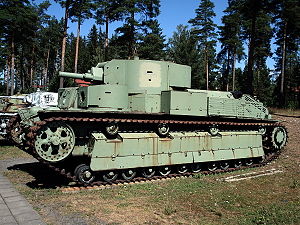T-28
| T-28 | |
|---|---|

T-28E registered as R-48, since 1943 Ps. 241–4, at the Parola Tank Museum in Finland
|
|
| Type | Medium tank |
| Place of origin | Soviet Union |
| Service history | |
| In service | 1933–45 |
| Used by | Soviet Union, Finland, Hungary, Turkey, Nazi Germany |
| Wars | Soviet invasion of Poland, Winter War, World War II |
| Production history | |
| Designed | 1931 |
| Produced | 1932–41 |
| Number built | 503 |
| Variants | T-28E, T-28 Model 1940, OT-28 |
| Specifications | |
| Weight | 28 tonnes |
| Length | 7.44 m (24 ft 5 in) |
| Width | 2.87 m (9 ft 5 in) |
| Height | 2.82 m (9 ft 3 in) |
| Crew | 6 |
|
|
|
| Armour | 20–30 mm |
|
Main
armament |
76.2 mm KT-28 cannon (70 rounds) |
|
Secondary
armament |
4 or 5×7.62 mm DT machine guns (8,000 rounds) |
| Engine | 46.9 l Mikulin M-17 V12 engine 500 hp (373 kW) |
| Power/weight | 18 hp/tonne |
| Suspension | twin bogies with plunger springs |
|
Operational
range |
220 km (140 mi) |
| Speed | 37 km/h (23 mph) |
The T-28 was a Soviet multi-turreted tank that was among the world's first medium tanks. The prototype was completed in 1931, and production began in late 1932. It was an infantry support tank intended to break through fortified defences. The T-28 was designed to complement the heavier T-35 (also multi-turreted), with which it shared turret designs. The type did not have great success in combat, but it played an important role as a development project for Soviet tank designers. A series of new ideas and solutions that were tried out on the T-28 were later incorporated in future models.
The T-28 was in many ways similar to the British Vickers A1E1 Independent tank, which greatly influenced tank design in the period between the wars, even though only a single prototype was manufactured in 1926. The Kirov Factory in Leningrad began manufacturing a tank that was based on the design of the British Independent in 1932. The T-28 tank was officially approved on 11 August 1933. The T-28 had one large turret with a 76.2 mm gun and two smaller turrets with 7.62 mm machine guns. A total of 503 T-28 tanks were manufactured over the eight-year period from 1933 to 1941.
The T-28 was deployed during the Soviet invasion of Poland, and the Winter War with Finland. During the initial stages of the Winter War, the tank was used in direct fire missions against Finnish pillboxes. In the course of these operations, it was found that the armour was inadequate and an upgrade was initiated. The frontal armour plates were upgraded from 30 mm to 80 mm and side and rear plates to 40 mm thickness. With this up-armoured version, the Red Army broke through the main Finnish defensive fortification, the Mannerheim Line.
According to Russian historian Maksim Kolomiets in his book T-28. Stalin's Three-headed Monster, over 200 T-28s were knocked out during the Winter War, but only 20 of them were irrecoverable losses (including two captured by the Finnish Army). Due to the proximity of the Kirov Plant, all other knocked-out tanks were repaired, some of them more than five times.
...
Wikipedia
